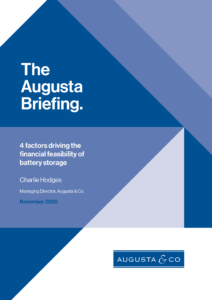As old thermal capacity is switched off and growth in renewables creates issues for grid management and balance, more system flexibility is needed for grid operators. One solution is new build storage, but new build economics are currently challenging.
Over 95% of the world’s operating energy storage is pumped storage, but new assets typically require subsidies to help mitigate the upfront cost and many of the best topographical sites are now taken. Lithium-ion (Li-on) storage can help meet the needs of grid operators in constrained areas more quickly and cheaply than pumped storage assets – albeit at 1-4 hr durations.
However, our view on the economics suggests that merchant revenues do not provide for quick payback. While we recognise a UK merchant asset is not necessarily representative of performance in other markets, we expect the merchant model to prevail as system operators resist procuring flexibility under long term contracts. We look at what is likely to change in coming years to reduce underlying equity risk and improve financial returns.
First, the rough maths on a typical UK BESS asset:
A 50MW 1hr Li-on battery asset costs roughly £20m to build. We have simplistically assumed that modest revenues come from ancillary markets including frequency response, TRIADs – which are being phased out – and capacity market revenues with most revenues from trading. In these conditions an average 50MW system should make c.£4k/month/MW.
This equates to £2.4m/year in revenues. Assuming a c.60% EBITDA margin and zero leverage, we get c.£1.6m of FCF/year which provides for a 12+ year payback – and that’s before considering what the merchant risk component means for return requirements. So, the question needs to be asked, if batteries are valuable for grid stabilisation and ancillary services, what factors are going to make the equity return more attractive over time?
To read the full Augusta Briefing on battery storage from Charlie Hodges, please click here.

